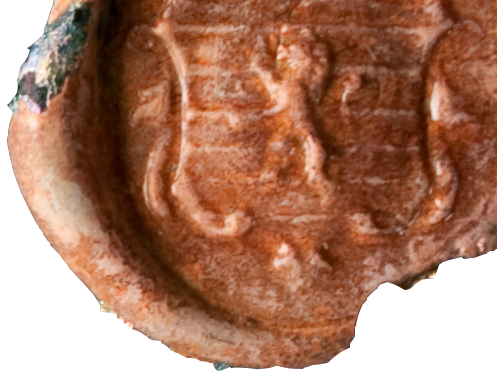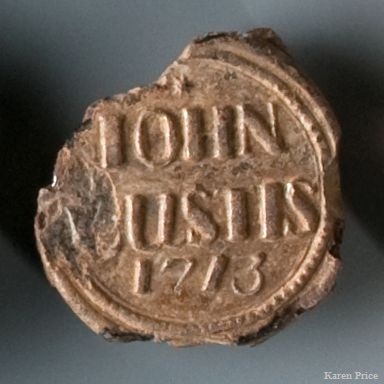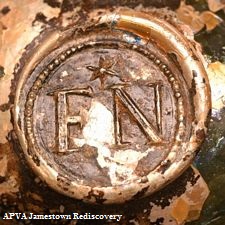

Anyone (21 and up, of course!) can pick up a bottle of wine from a grocery store without a second thought. Now, take a moment to think about what your purchase of that bottle of wine says about you as a person. The paper label on the bottle might say that you prefer red over white, or maybe that youíre okay with a bottle of Two-buck Chuck, or maybe that you had the expendable cash to splurge on a $150 bottle of wine. Are you trying to send a particular message about your social status, class, or taste levels with your choice in wine? The objects associated with mundane activities can say a significant amount about their owners. Rewind back as early as the seventeenth century, when the practice of personalizing wine bottles with identifying seals was a relatively widespread one. These marked wine bottles provide facts like the ownerís name and more importantly, they open the door to numerous other details about who owned the bottle.

The earliest known dated wine bottle seal was found in London, and belonged to John Jefferson in 1652 although there are several other undated colonial wine bottle seals from before 1652 (NoŽl Hume 1969: 61). The practice of marking wine bottles was popular throughout Great Britain and the British colonies into the late nineteenth century Personalized seals were affixed to wine bottles towards the end of the production process. When the wine bottle was fully made but the glass was still hot, the glassmaker attached an embossed disc of glass to the warm and adhesive wine bottle (Hancock 2009: 369). These discs were then impressed with a seal that had been specifically designed for a patron, or with the patronís initials (NoŽl Hume 1969: 61). Into the eighteenth century, glass bottles themselves were relatively rareómost people purchased wine in generic ceramic jugs, and glass bottles were a marker of wealth. Even after glass bottles became the norm, the additional cost and effort involved in adding a seal to a wine bottle meant that sealed bottles cost nearly 1.5 times unmarked bottles (Palmer 1993: 349).

Wine bottles with seals were certainly wealth markers and served as a way to show that the owner of the wine bottle was genteel (Hancock 2009: 369). However, the imagery on the seal itself can differentiate between different levels of gentility. Seals tend to contain some combination of elements from the following categories: symbols, crests, names, initials, and dates. Scholars have found patterns in the way these elements are used. For instance, taverns and inns tended to emboss their tavern symbols onto the seals. Historical archaeologist Ivor NoŽl Hume (1969: 61) suggests that initials (which could be embossed using a matrix instead of a custom-made seal) provided a way for people who were not extraordinarily wealthy to commission a custom seal to personalize their wine bottle. Historian David Hancock (2009: 370) suggests that labels with names are a marker of middle class people without a family crest but nonetheless wanted to own sealed wine bottles. The presence of certain sorts of imagery might give us an idea of the ownerís class, level of wealth, social situation, and reason for purchasing sealed wine bottles. Wine bottle seals were made for gentlemen, merchants and innkeepers.
This brings us back to the concept of wine bottle seals not just as individual objects, but as a class of material culture. These objects contributed to the owner's identity and his presentation as a cultured man. At once, wine bottle seals reflect the cultural milieu from which they were produced and contribute to the cultural milieu. This is why we were inspired to build a platform to capture (with your help!) wine bottle seals—they truly represent culture embossed.
Deetz, James
1977 In Small Things Forgotten: An Archaeology of Early American Life. Anchor Books, New York, NY.
Goodwin, Lorinda B. R.
1999 An Archaeology of Manners: The Polite World of the Merchant Elite of Colonial Massachusetts. Kluwer Academic/Plenum Publishers, New York, NY.
Hancock, David
2009 Oceans of Wine: Madeira and the Emergence of American Trade and Taste. Yale University Press, New Haven, CT.
McCracken, Grant
1988 Culture and Consumption: New Approaches to the Symbolic Character of Consumer Goods and Activities. Indiana University Press, Bloomington, IN.
Noël Hume, Ivor
1969 A Guide to Artifacts of Colonial America. University of Pennsylvania Press, Philadelphia, PA.
Palmer, Arlene
1993 Glass in Early America: Selections from the Henry Francis du Pont Winterthur Museum. W.W. Norton, New York, NY.
White, Carolyn L., and Beaudry, Mary C.
2009 Artifacts and Personal Identity. In International Handbook of Historical Archaeology, T. Majewski and D. Gaimster, editors, pp. 209-225. Springer Science+Business Media, LLC, New York, NY.